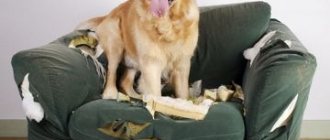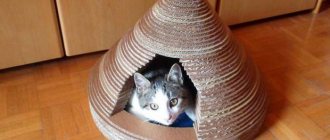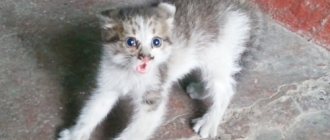Cats are the most popular pets. No matter what breed the purr is, or maybe even a mongrel, she is still a beauty, a graceful and affectionate animal! But not everything is as smooth as it seems, because cats also have a dark side - a terrible desire to sharpen their claws on everything that comes under their paws! Why do they do this? How to stop a cat from scratching furniture, wallpaper and other things? There are several ways. We will share with you the proven and most effective ones immediately after we find the reason for this purring behavior.
Why do cats sharpen their claws?
Our pet tailed purrs are not the only ones that scratch things around them. All wild cats, as well as homeless ones, scratch their claws on trees. This is necessary in order to mark the territory. The smell of a certain individual remains on the tree, as well as marks. Strangers, seeing the footprints and smelling the smell, will pass by and will not encroach on someone else’s property.
Also, all cats simply need to sharpen their claws - this is a kind of hygienic procedure. If you sharpen your claws on furniture, the fabric helps remove unnecessary parts of the plates, as well as scales that have served their purpose. This is how cats get a “manicure.” This helps keep the nails clean and they stay healthy longer. Surely, everyone has at least once found their pet's claw in the sofa or carpet. So, this is not an element that accidentally fell off due to too diligent carding, but material that has already served its purpose and is no longer needed. Cats simply don’t know any other way to get rid of it.
“Scratching” the claws is a physical necessity, as the cat practices the skills of releasing and retracting them. Pets don’t need this skill anymore, because they don’t need to hunt to eat or climb a tall tree to escape an enemy. But for cats, this is an exercise at the level of instincts that are passed on from generation to generation.
Some animals relieve stress this way, expressing their emotions, dissatisfaction, for example. When answering the question of how to stop a cat from scratching furniture out of spite, you must first figure out what the animal didn’t like so much!
Another reason is the expression of love. If a cat only attacks the chair you are sitting on, then it is about the person you love most!
We suggest moving on to the question of how to stop a cat from scratching furniture and other items in your interior.
Bonus: how to choose a scratching post?
In order for the kitten to really like the scratching post, you need to choose the right option. There are horizontal and vertical scratching posts. They are also made from different materials: cardboard, wood or rope.
When choosing a scratching post, you need to rely on your pet’s preferences. For example, if he likes to sharpen his claws on the carpet, there must be a horizontal scratching post in the house.
Basic parameters of a good scratching post:
- tall or long enough for the kitten to stretch out during the process;
- a high scratching post should be stable, not dangle or fall;
- natural materials.
If you have several scratching posts, it is good if they are made of different materials. Cats prefer natural materials: wood and sisal rope.
An excellent option would be a scratching post-house. This way you will provide your pet with a place to sleep and a place to stretch and train its claws.
Did you like the article? Tell your friends:
Comments
Will sterilization help?
As we wrote in the first paragraph, cats mark their territory by leaving their scent and marks. As many people know, if you sterilize an animal, it loses interest in the opposite sex. But sterilization will not help overcome the instinct to mark oneself with claws!
Yes, it is necessary to sterilize pets; this will protect them from many diseases and prolong their lives. You, in turn, will not need to listen to cat concerts or think about what to do with the offspring. How to stop a cat from scratching furniture and wallpaper? There are other productive methods.
How to wean a cat from a bad habit
There are several ways to stop a cat from tearing up furniture and wallpaper. For example, you can train an animal using commands or signals. To do this, it is recommended to use objects that make loud sounds (rattles, metal objects, balloons), as well as to say “no”, “no”, “fu” or hiss at your pet. It is recommended to use these measures before attempting to sharpen the claws or in the first seconds of this process.
Reasons for the popularity of furniture covers, types of models
For the pet, these actions will be associated with punishment, which will help to wean the cat from tearing up furniture. Another way to protect your home set is with adhesive pads. They can be attached to any surface.
scratching post
The simplest and most effective way to stop a cat from scratching furniture and wallpaper is to purchase a scratching post for him. There are many options on the market, there are both individual columns and built-in houses, entire complexes for games. It is worth purchasing a scratching post made of a material more similar to the one your pet has chosen in the house. For installation, you need to select a free corner or another area of the apartment. A place for the animal's needs can be made from a board, carpet, twine or regular clothesline. This requires wrapping the material around a rigid and stable base.
To accustom your pet to a scratching post, you can use catnip or valerian (infusion). This area is first coated with the substance, after which it is brought to the animal’s device. It is necessary to start playing with the cat so that it releases its claws. After this, her paw needs to be brought to the structure, copying the natural sharpening. It is recommended to repeat the process until the animal gets used to it and begins to do it on its own. The scratching post for cats needs to be made large enough so that the pet can fully stretch out.
Equipment for a personal sleeping area
To prevent your cat from tearing up furniture and wallpaper, it is recommended to make a personal place for him to sleep. This will reduce the animal's stress if people have multiple pets. You can use special houses, sun loungers or ordinary cardboard boxes. You need to choose a suitable space for installation and accustom the cat to it using training or aromatic substances (mint, valerian).
Classification of modern types of fabrics for furniture, selection criteria
It is recommended to place the pet's house near a place where people are often present, since cats love company and rarely tolerate loneliness. It is necessary to wean other animals from trying to occupy someone else's house and equip a separate one for each. This will reduce the number of stressful situations for cats and help prevent property damage.
Water use
You can use a spray bottle if you need to stop your cat from scratching furniture, as animals are afraid of water. To do this, you need to spray the device into his face or onto his fur. It is important to avoid getting liquid into your cat's ears, as it can cause disease or inflammation. You can add various aromatic substances to the water that repel pets, for example, citrus juice or spices. You should spray water on animals very carefully, as you can get into household appliances or wet the wallpaper.
If you splash a cat after the claw point, he will not understand why he was punished.
Wallpaper protection
If an animal scratches wallpaper or furniture in one place, then you should get fabric covers. They are easy to attach to the surface using nails, glue, and paper clips. The damaged area can be covered with adhesive tape. It is subtle, but effective against cats, as they really don’t like it when something sticks to them. You can also use a woven cotton rug that is attached to a wall or furniture. It, like fabric, will allow your pet to sharpen its claws without damaging interior items.
It is recommended to choose liquid, slippery wallpaper or replace old ones with them. This way, the cat will have nothing to cling to, and it will stop tearing at the wall. The most drastic solution may be to cover the damaged areas with tiles or decorative plaster.
scratching post
You can find this useful item in every pet store. A scratching post can be a post, a plank, or a whole castle with shelves for climbing, a place to sleep and various toys. The scratching post, whatever it is, is covered with durable fabric or rope, which is very convenient for scratching claws. By the way, you can make a scratching post at home at very little cost. You will need a board, twine, glue. Apply glue to the board, then wrap it tightly with rope, dry it and give it to your cat!
But some complain that this thing is useless, and the pet simply ignores it! Do not forget that even a person who sees a new thing will not immediately understand what it is for. The cat needs to be accustomed to the scratching post by distracting it from the furniture. To make the animal comfortable and safe, attach this thing securely (to support the weight of the cat), at a height where the purr can easily reach. If there is no interest in a new item yet, try applying a little valerian to the fabric; it will certainly not leave the animal indifferent!
If the apartment is large and several cats live in it, then one scratching post will not be enough. Cats believe that they are the masters of the house, and therefore will sharpen their claws in any place. To do this, distribute scratching posts throughout the house, in the animals' favorite places.
It’s easier for kids to adapt to such a subject. Buy a scratching post as soon as you get a pet, so you don’t have to wonder how to stop a kitten from scratching furniture and wallpaper. Reviews on this matter say that the thing is really necessary. It is recommended to accustom him to a scratching post in his favorite place to play. One lesson is enough for some, but there are cats who, even in a year, will not understand what a person wants from them! If you have a scratching post, but you still haven’t been able to figure out how to stop your cat from scratching furniture and wallpaper, then choose another method.
If all else fails
If water and a scratching post do not solve the problem, you will have to think about how to stop your cat from scratching furniture, using more serious methods. You can use special silicone attachments for animals. They are attached to the claws with an adhesive substance and last from 1 to 2 months. After the upper horny part of the cat's toe peels off, the pad falls off along with it.
An alternative to silicone devices is surgical declawing. This procedure is not recommended for use as it is similar to amputating a human finger and is not humane.
You can also protect items from the kitten using covers. They are similar to fabric covers that are attached to the surface, but cover the entire furniture or a separate part of it. If a cat is tearing at an element of the interior, it is recommended to use a spray with a strong repulsive odor. You can find it at a veterinary pharmacy or prepare it yourself. This substance has an unpleasant aroma for cats and can discourage the animal from any furniture. You can mix essential oils, spices, citrus juice with water, or hang bags of spices near the problem area. This method is not always suitable, since the listed substances emit an unpleasant aroma for humans and can also leave streaks and stains.
Rules for cleaning leather furniture at home, review of products
Silicone claw pads
Repellent spray
Furniture covers made of anti-vandal fabric
A mixture of water and essential oils
Silicone claw pads
This is a relatively new method to protect your home from the restless paws of purring cats. Today there are simply incredibly beautiful overlays for cat claws; any fashionista will envy their manicure! The downside of this method is that it is a bit expensive and not entirely simple. Special caps must be placed on the claws using glue that is safe for the animal. Every few weeks you will have to remove the false claws, file down the real ones, and glue the caps back on.
At first, the cat will feel some discomfort, even though the caps are almost weightless. But soon the fashionista will get used to it and stop paying attention to her paws.
There is one more disadvantage: some too smart individuals quickly realize that everything that can be put on can be taken off! As soon as they learn to do this, they will quickly get rid of their manicure and go blissfully scratch their claws on the sofa.
How to stop a cat from scratching furniture, doors and other things? If none of the previous options are suitable, then we suggest considering others, but not all of them are as humane.
Onychectomy: pros and cons
Simply put, this is the complete removal of cat claws. Some people don’t even think about how to stop a cat from scratching furniture, and to save their property, they take their pet to a veterinary clinic. It seems like a simple operation, but why doesn’t any good vet recommend it? Here's the thing:
- During the operation, not only the animal’s claws are removed, but also some of its fingers so that there are no more problems!
- Cats tolerate anesthesia very poorly.
- A cat without claws is disabled! The animal loses coordination of movements and cannot move as gracefully. If the cat wants to jump higher, he will simply fall down, because he has been deprived of clues.
- Due to the discomfort experienced, posture may deteriorate, and in the future the animal will suffer from back pain.
- The life of an animal after such an operation will turn into an endless stretch of stress!
How to stop a cat from scratching furniture? Definitely not through declawing surgery. Without them, a cat ceases to be a cat. Let's look at other ways to protect the interior.
If you don’t find any other way, then just try trimming your pet’s nails. This will not harm his health, the furniture will remain safe and sound.
Special sprays
At any pet store, ask for a spray that is used to spray areas of furniture to protect against cats. The fact is that such liquids are practically imperceptible to the human nose, but cause disgust in cats. As soon as the animal approaches its favorite place, it will be scared off by an unpleasant smell, and the cat will go to scratch in another place. At least that's what the manufacturers of such drugs say. In fact, not every pussy will desperately rush away as soon as it catches an unpleasant smell. Some will “wince” but continue to scratch the sofa, even if it is completely covered with this liquid!
What cats definitely cannot stand is the smell of citrus fruits, onions and vinegar. The last two will also be unpleasant for the owners of the house, so it’s better to choose the first option. Buy eucalyptus oil and citrus oil, mix them, spray all the places where the animal chooses to sharpen its claws.
How to stop a cat from tearing up furniture
Even if deep down in your heart you completely justify this behavior of your mustachioed pet, you don’t want to live with forever tattered furniture. The animal must be weaned from scratching the chair and new habits must be established for it. If a cat is tearing up furniture, what should you do? There are several options for resolving the problem.
There are several ways in which you can distract your cat's attention from the furniture.
Loud sounds
Loud noises distract the cat from the sofa. If you regularly shout at the animal, it will understand that you are unhappy. It is important to establish this rule at the level of instinct: as soon as the sofa turns into a scratching post, immediately scream at the cat or make a loud bang. The animal doesn’t like this, gets scared, panics, and runs away.
You can distract your cat from the sofa by scaring him with a loud bang. Over time, he will establish a direct connection between unpleasant sensations and sharpening his claws on the sofa. It is important to offer the cat an alternative - a scratching post from a pet store or one made by yourself. If you don't want to scream, use a rattle, bell, whistle, or other object that makes a loud, sharp sound to make a loud noise.
In addition to cotton, you can distract the attention of the tailed animal with any sharp sound.
Voice command
Cats are smart and understanding animals. There is an opinion that they cannot be trained. But that's not true. In fact, they are wayward animals that do not like to be obeyed.
Regardless of the breed, each cat has its own character and can be capricious. A voice command is a call to immediately stop an unwanted action. When the pet understands that you are not joking, he will begin to obey.
Cats are much smarter than they might seem. Sometimes you can achieve results using voice commands.
Spray bottle with water
Along with a loud voice and command, you can use spraying with water. As a rule, cats do not like water procedures and avoid it in every possible way. If you sharply spray the cat with water while damaging the sofa, it will work.
A spray bottle can help solve many problems with a cat. The downside to this method, like the three previous ones, is that it only works if you are nearby. As soon as there is no one at home, the cat will freely sharpen its claws on everything that comes under its paws.
Spray from a spray bottle will cool the cat quickly, but, naturally, you won’t be able to use it when you are not at home.
Features of smells
What can you do to prevent your cat from tearing up furniture if you don’t scare him with bathing? It's easy to find out which odors your pet can't stand. It is known that cats' least favorite smells include tangerines, oranges and other citrus fruits. Buy essential oil or fresh fruits and apply it to a favorite place where the animal prefers to damage furniture.
The aromas of various citrus fruits will help scare away cats. In pet stores you can also find special repellent sprays with an unpleasant aroma for cats.
There are a huge number of different repellent sprays on the pet supplies market.
Sticky surface
To make your cat permanently lose interest in damaging furniture, use sticky tape. Cats hate the sticky feeling on their paws and avoid such places.
Sticky double-sided tape will help keep your cat away from the furniture. Take double-sided tape and attach it to your pet's favorite exercise spots. Pet stores also sell special adhesive tape for animals.
You can use either regular double-sided tape or tape sold in pet stores. Replace the tape with a new one until the animal weans itself from the bad habit.
Adhesive tape should be applied to areas of furniture that attract cats.
Nail trimming
Using a nail clipper, you can cut your pet's nails yourself. The procedure must be carried out regularly and extremely carefully.
Regular nail trimming increases the chances of keeping your furniture intact. Then the animal will have nothing to injure the surface of the furniture. And the cat’s soft paws will not harm your favorite sofa.
It is almost impossible to seriously damage furniture with soft paws.
Closed doors
It happens that cats damage unique, antique furniture. Unfortunately, animals don’t understand art and a sofa for him is just an ordinary wooden surface for sharpening his claws. In this case, close the doors to the room and do not let the animal in from the moment you got it.
One option is to simply not let the cat into the room where there is furniture that is important to you. An animal that has never been to a certain territory will lose interest in it or will perceive it as something alien, unfamiliar and scary.
Gradually, the animal should lose interest in the unknown.
Anti-scratch
To prevent your cat from scratching the sofa, purchase special anti-scratch pads. They are adhesive silicone caps on the claws. It looks funny and is safe for your pet. The accessory does not harm the furniture, even if the cat wants to sharpen its claws on it.
Anti-scratch kits on a cat look very cute and funny. Over time, you can stick on new anti-scratch pads or cut them off along with the growing claws.
It is almost impossible to damage furniture with such legs.
Repellers
How to stop a cat from scratching furniture and walls? This question is very relevant for everyone who has a purr. You can scare the animal at the moment when it approaches its favorite place and is about to get down to business. Make a rattle using a tin can or nylon bottle filled with pebbles. Start rattling next to the animal only at the moment when it releases its claws, but not before, and especially not after. The cat must understand why it gets this unpleasant sound!
You can use balloons. Every time your cat begins to sharpen her claws, pop a ball next to her. As soon as the purr begins to recognize this object and is afraid of it, hang the balls in all the places where the pussy scratches its claws.
Why does a kitten sharpen its claws?
Let's first figure out why the newly minted pet sharpens its claws. This will help you understand why the kitten chose a sofa as a scratching post.
Stretching. When a kitten sharpens its claws, it stretches its muscles and tendons.
Marks. Cats mark their territory not only with a special odorous secretion. There are special scent glands on the paws. When a kitten scratches a chair leg, he marks it not only visually, but also with his scent. A person does not smell this smell. But other cats feel it. Such marks are an important part of communication with other animals.
Nail care is the most obvious reason. The kitten grinds down its claws and sheds their outer shell. If you look closely, you can see fallen pieces of the shell in the place where the kitten regularly sharpens its claws. This way the claws remain healthy and well-groomed. You can help your kitten with a manicure and trim his nails regularly. This way the kitten will scratch the furniture less.
Feeling good is another reason to sharpen your claws. The process helps manage stress and reduces your pet's desire to scratch your arms or legs.
How to stop a cat from scratching furniture using improvised means?
Fill the spray bottle with water. And as soon as your pet starts tearing up the sofa or other unauthorized place, sprinkle water on it! There will be no harm to either the cat or the furniture, but the pet will begin to associate its favorite activity with unpleasant phlegm!
If you are thinking about how to stop a kitten from scratching the sofa, then this method is unlikely to work. Usually, kids accidentally damage furniture while playing. They begin to climb the curtains, try to conquer the sofa, the carpet hanging on the wall - this is normal behavior. If you pour water on your kitten every time he plays, you will simply grow a nervous creature, apathetic to everything. The same applies to scaring sounds.
Sticky surfaces
How to stop a cat from scratching the sofa? Just let it stick once or twice! Attach double-sided tape to the upholstery. As soon as the animal approaches to scratch its favorite place, it will immediately stick its paw or fur on its side. Cats hate being clingy, so you won't need a lot of lessons.
Place the tape in all places where the cat sticks its claws - the window sill, corners, doors, and so on. Soon the animal will avoid dangerous places three meters away!
If a cat destroys the owner's furniture out of spite
This happens very often! The pet will look you in the eye, knowing that you shouldn’t scratch the sofa, but will continue, because he’s doing this out of spite! Why is this happening? Find the cause of dissatisfaction and eliminate it. For example, the animal did not like the food, its tray was not washed, it was not given a treat, it was scolded. Or maybe the cat simply cannot stand the smell of detergent or the owner’s perfume? How to stop a cat from scratching furniture in this case? Monitor your pet's behavior: how he behaves before and after washing the floors, how he reacts to new smells and other people. As soon as the cat starts tearing the furniture, remember what preceded it. You will find the reason quickly, because the animal will show its dissatisfaction as soon as something is not the way it wants!











